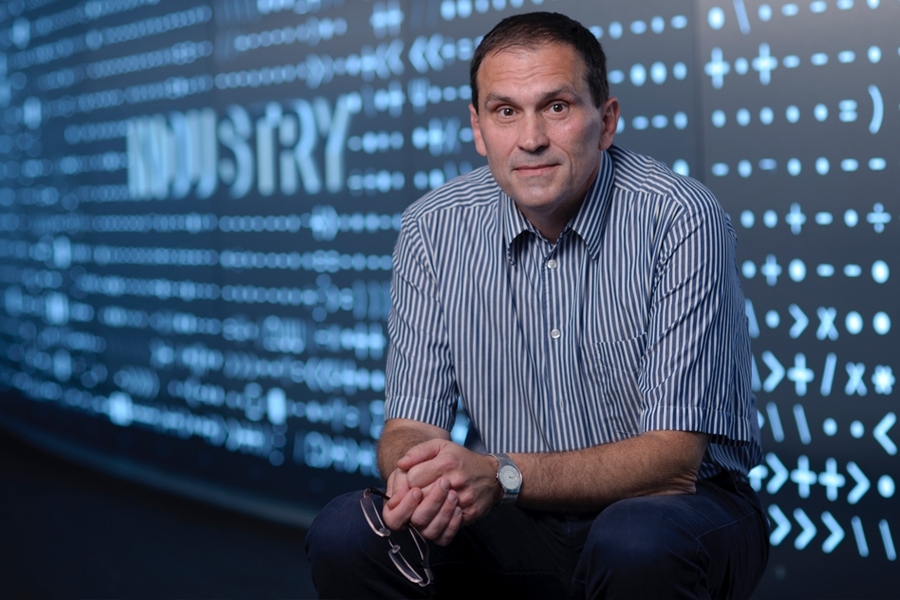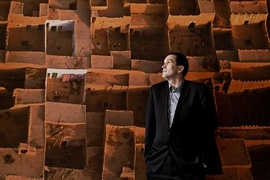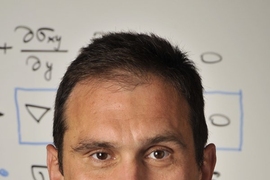Franz-Josef Ulm works on big issues such as concrete manufacturing, urban architecture, and gas shale recovery. All involve “the physics of what many consider dirty materials and messy systems,” he says. His intent is to make each of these more efficient, durable, and environmentally sound.
While the vision is grand, the approach is anything but. The civil and environmental engineering professor and co-director of the MIT MultiScale Material Science for Energy and Environment international joint unit (MIT-CNRS-UMI), a venture between the Institute and France’s National Center for Scientific Research, works from nanoscale to city-scale. The nanoscale helps him better understand the fundamentals of old processes, bringing about core changes in a material’s behavior that can be actualized at the city-scale. Beyond stronger concrete and more resilient cities, Ulm’s research could translate into bigger applications, namely better automotive fuel consumption, less flooding damage, and lower utility bills.
Constructing better buildings
Concrete is the most produced material worldwide. That ubiquity exacts an environmental toll: Every person consumes an estimated 1 cubic yard every year, Ulm says. His goal is to reduce the overall footprint by creating a new scientific basis for engineering concrete using elements of glass physics developed over the last decade. This molecular-scale approach allows modification of the behavior of electrons and atoms, thereby modifying the large-scale behavior of roads, buildings, and bridges.
The result is a concrete with enhanced strength and fracture resistance, something twice as strong as the industry standard. “Ultimately what we produce is a material where you will use less for a higher performance,” he says. The remaining question is how it can be used. Ulm says that, along with as a substitute for steel, one potential is to improve fuel consumption. In driving, there’s a phenomenon in which cars always travel on a slight slope. It’s like walking on a beach — the foot is always overcoming pressure to keep moving forward. On roads, the consequence is up to 3 percent in excess national fuel consumption, he says. With stiffer pavement, the problem dissipates.
Ulm’s work fits in with a bigger picture at MIT. There are numerous professors working on independent nanoscale-level projects. Now there’s the newly established NanoMechanical Technology Laboratory, or NanoLab. The building will be able to house related work, with meeting space and shared equipment. It will also allow for intra-department collaboration, something Ulm says has always led to breakthroughs in his research, adding, “This would be basically a hub of nanoscience and engineering at MIT.”
Making cities work
The nanoscience approach employed for concrete is also relevant for the work Ulm is doing on urban physics with his colleagues in the MIT-CNRS-UMI. He looks at the complexity of cities and how to make them more resilient in the face of crises and climate change. It’s a growing necessity, he says, since by 2050 estimates have 70 percent of the world’s population living in urban areas.
Ulm has looked at 12 different United States cities, and, using molecular science, he and his collaborators have broken them down to their individual components, “basically atomizing cities into their elementary building stock,” looking at factors such as how they’re designed and the distance between buildings. From all of this, as examples, he found that Boston is like a liquid, New York, a glass, and Chicago, a crystal.
What does that mean, exactly? By seeing a city’s details, Ulm says that his students can run computer-simulations, take a few traceable qualities well defined by statistical physics, and determine the response to a storm or an earthquake. He’s also been able to study an issue like the severity of the heat island effect — when the temperature inside the city is higher than outside, requiring more heating and cooling.
As it stands, city planners often use metrics such as population density as a guide in making decisions. But that measurement misses what makes each city unique. “There’s an intimate interplay between a city and its texture,” Ulm says. More than an average number, what’s needed to know how much the local building density varies from the average, much akin to atomic positions in molecular structures.
These designations provide that nuance. For example, a liquid, like Boston, has no order, which is beneficial for an issue like the heat island effect — a disordered structure leaves enough space for heat to escape; whereas an ordered crystal, like Chicago, exhibits high urban heat island effects that must be offset by additional heating and cooling energy. But with something like storms, a glass-structured city, like New York, wouldn’t let water escape, and the flood risk would be higher.
Knowing the texture can help officials make informed choices for addressing climate issues in existing cities and designing new energy efficient ones for growing and shifting population demographics.
Extracting energy
Ulm’s third area of focus is shale gas, an energy source that holds enormous potential as a bridge between fossil-oriented systems and green technology, he says. But it also comes with challenges. Shale is recovered at a depth of 3-4 kilometers at both high temperatures and pressures. The actual gas is contained in a carbon-based material, kerogen. Little is known about the structure of kerogen, and Ulm says that he is looking at how the gas can be safely recovered.
Since kerogen is carbon-based, the opportunity exists to bring the well-developed field of carbon science into the realm of geoscience. The hope is to create a process without severe environmental impact. Hydraulic fracturing is the standard method, but it uses water and high pressure to create cracks in the rock around the steel pipe at high depths into which the gas would escape. Since carbon is hydrophobic, there is little chance that the water can push the gas in the nanoporous carbon out into the cracks and be ready for recovery. In addition, the water employed comes at a non-negligible environmental price, as what is recovered — and a majority isn’t — becomes salty and contaminated, he says.
Redefining kerogen in the terms of carbon science, Ulm and his UMI colleagues suggest the employment of carbon dioxide instead of water. Carbon dioxide has a natural affinity to the carbon solid of kerogen and would replace the shale gas adsorbed in kerogen. The carbon dioxide stored into the kerogen at 3-4 kilometers depth could then become part of a larger carbon capture-and-sequestration scheme, and the process would become carbon-neutral. It would mean not only a gentler process but also a more productive and sustainable one.
Because of the porous nature of kerogen, the gas industry only recovers about 10-20 percent of what’s available, Ulm says. His work is to address the remaining 80 percent. “It is this focus point which we believe our research will impact most,” he says.









